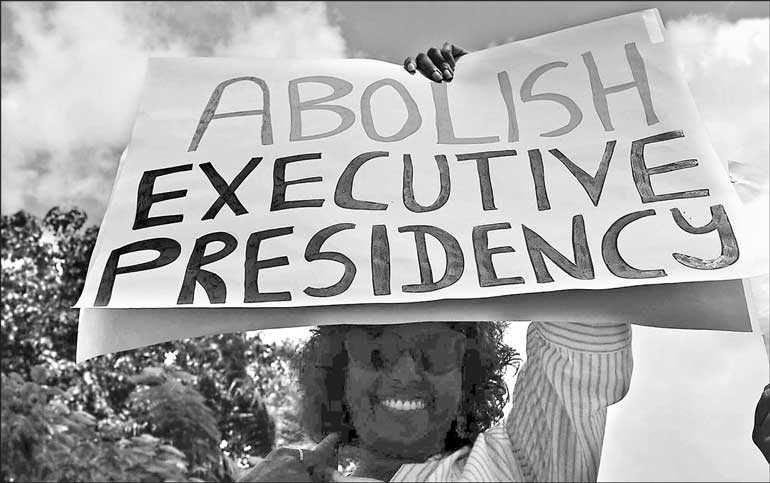Tuesday Mar 18, 2025
Tuesday Mar 18, 2025
Saturday, 9 March 2019 00:00 - - {{hitsCtrl.values.hits}}

 Only two out of seven times in the last Parliamentary Elections in Sri Lanka has a party or alliance won even a simple majority. Five out of Sri Lanka’s last seven parliaments have started out as hung parliaments. The only two exceptions were in 1989, when the UNP led by late President Premadasa won a majority and in 2010 when the UPFA led by Mahinda Rajapakse won a majority.
Only two out of seven times in the last Parliamentary Elections in Sri Lanka has a party or alliance won even a simple majority. Five out of Sri Lanka’s last seven parliaments have started out as hung parliaments. The only two exceptions were in 1989, when the UNP led by late President Premadasa won a majority and in 2010 when the UPFA led by Mahinda Rajapakse won a majority.
1989 and 2010 Parliamentary Elections
The Parliamentary Elections of 1989 and 2010 were the only times a party or alliance produced a majority. But even these two elections were exceptions. The 1989 General Elections where the UNP under Ranasinghe Premadasa won 125 seats was an election that followed a Presidential Election in late 1988 which was won by the then UNP leader Ranasinghe Premadasa.
It is a known fact that once a Presidential Election is won by a party and if a Parliamentary Election follows within a few months, it is already a foregone conclusion that the party which won the presidency will win the Parliamentary Elections as well.
As the people have decided which party they want for the next five to six years at the Presidential Elections itself, the Parliamentary Elections is just reconfirming it. The same could be said for the 2010 Parliamentary Elections as well where that too followed a Presidential Election which was won by former President Mahinda Rajapaksa.
That leads to the finding that even the only two parliaments which did give the winner a majority were heavily influenced by Presidential Elections held a few months before the Parliamentary Elections. What if there were no Presidential Elections in 1988 and 2010? Would the Parliaments of 1989 and 2010 have had majorities? Maybe they would have as both President Premadasa and President Mahinda Rajapaksa were popular at the time but may have gotten a lesser number of seats as the two elections would have been seen as a more equal battle between the two parties.
An example of Israel
In an article I wrote for DailyFT in 2018, I did a study of Israeli politics. It has more details. Israel is an example of a country with the proportional representation system but without an Executive Presidency. Israel has a ceremonial president. A study of the political history of Israel shows how the system causes instability. Israeli got to a stage where the two largest parties combined got only 45% of the seats.
The current Government of Prime Minister Benjamin Netanyahu has six parties coming together. Instability causes governments to be very weak and important national issues are impossible to pass as even a party with less than 3% of the votes and representation in Parliament can blackmail the Government by threatening to leave the Government which would cause its downfall.
This also encourages extremist and fringe parties to control the Government as is seen in Israel where small extremist parties are able to control the Government and force their policies even though over 90% of the Israeli people may not necessarily be in favour of those policies.
Smaller parties
The problem with abolishing the Executive Presidency is that it is not easy to change the proportional representation system while abolishing the Executive Presidency. The smaller parties may be supportive of abolishing the Executive Presidency but they will not be in favour of moving away from the proportional representation system and towards the first past the post system. Many of the smaller parties cannot win a single seat under the first past the post system as that heavily favours a two-party system. Constitutional change is not possible without the support of the smaller parties leaving the country in a constitutional dilemma.
Conclusion
Not just the smaller parties but even the UNP may not want to move away from the proportional representation system. The example I often use is that in 1970, the UNP got more votes than the SLFP but the SLFP got over two-thirds of the seats in Parliament under the first past the post electoral system.
The UNP in 1970 won more votes but lost the election. This was unfair. Former President J.R. Jayewardene knew this and so changed the system. That is the flaw of the first past the post system as I have written in an earlier article.
An example is India, where the Modi-led BJP got only 31% of the votes but won over half the seats in Parliament in 2014. Going back to the first past the post system in Sri Lanka can result in a party with less than 30% of the votes winning comfortably.
Abolishing the Executive Presidency and leaving the proportional representation system can cause instability but changing back to the old first past the post system can result in a party not favoured by the Sri Lankan people coming to rule them. Sri Lanka is indeed in a dilemma.
References
http://www.ft.lk/columns/A-look-at-Israeli-politics%E2%80%93Proportional-Representation-without-the-Executive-Presidency/4-654845
http://www.ft.lk/columns/A-look-at-British-politics--Should-Sri-Lanka-revert-to-First-Past-the-Post-system-/4-655232
Discover Kapruka, the leading online shopping platform in Sri Lanka, where you can conveniently send Gifts and Flowers to your loved ones for any event including Valentine ’s Day. Explore a wide range of popular Shopping Categories on Kapruka, including Toys, Groceries, Electronics, Birthday Cakes, Fruits, Chocolates, Flower Bouquets, Clothing, Watches, Lingerie, Gift Sets and Jewellery. Also if you’re interested in selling with Kapruka, Partner Central by Kapruka is the best solution to start with. Moreover, through Kapruka Global Shop, you can also enjoy the convenience of purchasing products from renowned platforms like Amazon and eBay and have them delivered to Sri Lanka.
Discover Kapruka, the leading online shopping platform in Sri Lanka, where you can conveniently send Gifts and Flowers to your loved ones for any event including Valentine ’s Day. Explore a wide range of popular Shopping Categories on Kapruka, including Toys, Groceries, Electronics, Birthday Cakes, Fruits, Chocolates, Flower Bouquets, Clothing, Watches, Lingerie, Gift Sets and Jewellery. Also if you’re interested in selling with Kapruka, Partner Central by Kapruka is the best solution to start with. Moreover, through Kapruka Global Shop, you can also enjoy the convenience of purchasing products from renowned platforms like Amazon and eBay and have them delivered to Sri Lanka.